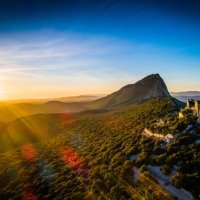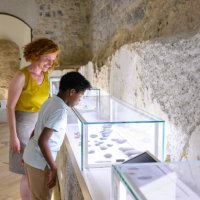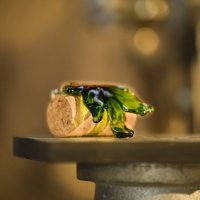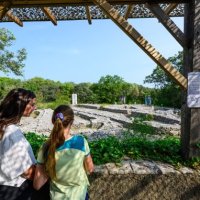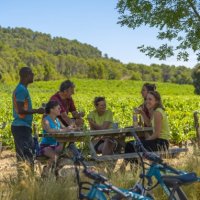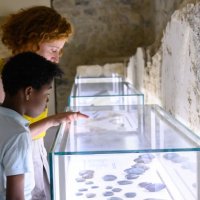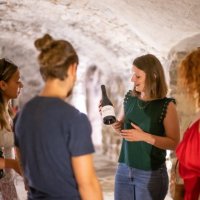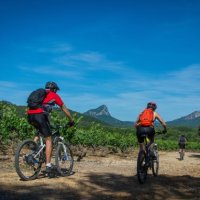The Wells of Fontanés...
A story of water and stone by Philippe Causse
The region of the "garrigues", which has always been inhabited, is by nature a "dry" region. Man, a breeder-farmer, settled where there was arable land.
Water, which is essential to the life of men, their crops and their animals, is often scarce.
If the villages are not located near springs or rivers, it must be "domesticated", either by fetching it from underground (wells) or by collecting rainwater, and in both cases it must be stored (cisterns or tanks). Fontanès, as its name indicates, is a place where water is found. The water is not very deep, about -1m in the old village, besides no house has a basement...
You may have one at home, you have certainly seen several in the village... There are, in the commune of Fontanès, 32 wells listed, they are either still in activity or condemned or blocked. A well (always written with an "s") is a construction whose purpose is to draw water from the groundwater and bring it to the surface.
There are several types of wells, they can be classified according to their age, the construction technique and their owners, private or public (4 wells are communal).
In Fontanes, "pulling" water was done in several ways:
By the force of a person: The simplest, a container (usually a bucket) is lowered to the bottom of the well and raised with a rope pulled directly or with a pulley. More recent and more advanced, a hand or wheel pump is used. A piston slides in a cylinder, creating a vacuum and the water is "sucked" out. This is the technique used in Fontanes for almost all the wells.
The oldest are the "simple" wells, a vertical gallery built of stones whose width is usually just enough for the builder (the Puisatier) to dig it. They have a coping often covered with a slab in which a pulley is fixed. The most recent ones are made of cut stone, with a hand pump operated by a lever or a wheel. They are built on a vaulted reservoir with a greater storage capacity, for domestic or agricultural use. Two of these wells are communal.
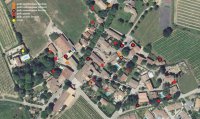
By the force of an animal: The "noria" (word of Arabic origin) or rather
The "noria" (Arabic word) or rather "Persian wheel" is a hydraulic machine that allows water to be raised using the energy produced by an animal, in order to water crops. The animal (donkey or mule) turns around an axis and sets in motion an endless chain wrapped around a drum and on which is attached a series of containers that draw water and pour it, at the top, into a stone tank, then it flows into a system of pipes and irrigation channels.
There was a waterwheel in Fontanès (still visible, but incomplete) on the RICOME family estate. In the summer, the wells were also used to keep the family drinks or the Café "cool"... sometimes the bucket was overturned, bottles are still at the bottom of some of them...
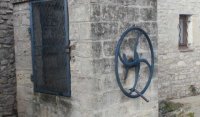
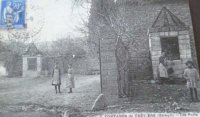
To these 25 wells in the old village, we must add 7 others:
- Two wells in the vineyards, to the south, under the sheepfolds (Jasses) of Mas de Jons.
- A well (blocked) on the road between the village and Laroque, on the D109E4. - Another one on the Domaine de Laroque, maybe two?
- One in the "Jardin de Fontanès" on the D109E4 road, called "de la Vieille".
- One at n°2, Ancien Chemin d'Anduze, route départementale D109.
- One in the future (and former) shared communal gardens, noted "Fontaine" on the "Plan de la Commune de Fontanès" dated 20 Thermidor de l'An 11 (8 August 1803).
As drinking water was lacking in summer, the municipal council, on February 18, 1894, under the presidency of Joseph ICARD, mayor, planned to dig a communal well (1200 francs, subsidized by the department for 200 fr). This well is located in the dead end called "du Puits" (see postcard opposite).
On October 19, 1904, still under the municipality of Joseph ICARD, another project of digging a larger communal well, next to an old one, whose coping and lintel are still visible (known as Puits Mira-baud) in the street of the same name, was born (completed in November 1905, for an amount of 1250 fr, subsidy of 625 fr).
According to René CAMMAL " Raconte-moi FONTANES ".
